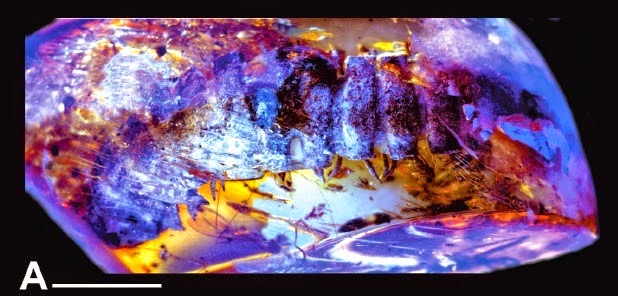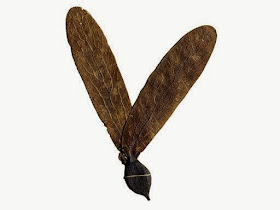Amber is the mineralized remnants of resins secreted by ancient
plants. It is valued by palaeontologists due to the frequent presence of
preserved insects, pollen and soft-bodied micro-organisms within amber clasts;
it is also widely used in the jewellery industry, and in Chinese medicine. The
resins which form amber are known to have originated from a number of different
plant groups, including Pines, Dipterocarps, Sciadopityas (Japanese Umbrela Pines), Araucarias,
Cypresses, Yews, Legumes and other Conifer and Angiosperm (Flowering Plant)
groups. Amber is traditionally collected from three sites in China, Fushun in
Northeast China, Xixia in Central China, and Zhangpu in Southeast China. The
Early Eocene Fushan Amber has been extensively studied, due to its frequent
Insect and Plant inclusions, and is considered to have been produced by a form
of Cypress, however the other two sources have not to date produced any fossil
inclusions, and therefore have been largely overlooked in other studies.
In a paper published in the journal PLoS One on 29 October 2014, Gongle Shi of the State Key Laboratory of Palaeobiology and Stratigraphy at the Nanjing Institute of Geology and Palaeontology of the Chinese Academy of Sciences, SuryenduDutta and Swagata Paul of the Department of Earth Sciences at the IndianInstitute of Technology Bombay, Bo Wang, also of the State Key Laboratory of Palaeobiology
and Stratigraphy at the Nanjing Institute of Geology and Palaeontology and of
the Steinmann Institute at the University of Bonn, and Frédéric Jacques of the
Key Laboratory of Tropical Forest Ecology at the Xishuangbanna TropicalBotanical Garden of the Chinese Academy of Sciences, discuss the chemical
composition of the Xixia and Zhangpu Ambers, as determined by gas
chromatography-mass spectrometry, and the implications of this for the
botanical origins of the amber.
The Xixia Amber originates from the Late Cretaceous Gaogou Formation
in Henan Province in Central China. The beds which produce it are best known
for their production of well-preserved Dinosaur eggs, and have also produced
Bivalve and Ostracod assemblages, but neither plant macrofossils nor pollen.
They are interpreted as non-marine sedimentary deposits, with layers of
mudstones, siltstones, sandstones and conglomerates. Xixia Amber is extremely
abundant, but typically comes in tiny opaque lenses in yellow, brown, brownish
yellow or brownish red. To date no fossils have been reported from Xixia Amber.
Late Cretaceous Xixia Amber. Shi et al. (2014).
The Xixia Amber proved to be rich in abietanediterpenoids, which is
taken to be diagnostic of a Coniferous rather than Flowering Plant origin, as
they are derived from abietic acid, which is produced by almost all Conifers,
but not Angiosperms. The amber does not contain labdanedericatives, which are
produced by Pines, and does contain tetracyclic diterpenoids, which are not, so
Pines are therefore ruled out as the origin of this amber. Neither were cedrane
and cuparane, produced by Cypresses, nor totarol, ferruginol orsugiol, produced
by Cypresses and Podocarps, found in the samples, making it highly unlikely
that the amber was of Cypress origin. The amber did contain tricyclic rimuane,
which is produced by Podocarps and Araucarias, and phyllocladane, which is
produced by Podocarps, Araucarias and Cypresses, from which Shi et al. conclude that the amber is most
likely to have originated from a form of Araucaria.
Araucarias today are mainly restricted to the Southern Hemisphere,
being found in Malaysia, Indonesia, Philippines, New Guinea, Australia, New
Zealand, New Caledonia, Vanuatu, Fiji, Norfolk Island and southern South
America, as well as being introduced in other areas as ornamental plants.
However they are known to have been widespread in the Northern Hemisphere
during the Mesozoic, and have been previously linked to amber deposits from the
Early Cretaceous of Spain and Jurassic of Thailand. Shi et al. also note that while amber is found throughout the Mesozoic,
it becomes much more widespread from the Early Cretaceous onwards, a timescale
which also coincides with a major radiation of the Araucarias, making it
possible that many Mesozoic ambers originate from these trees.
Podocarps are today found in tropical and subtropical upland forests
in both hemispheres, reaching their northernmost distribution in southern China,
Japan, Mexico and the Caribbean Islands. However modern members of the group
produce much less resin than Araucarias, making them a less likely source of
origin for ancient ambers, and the group is not thought to have been present in
China during the Cretaceous.
Shi et al. also note that
an extinct group of Conifers, the Cheirolepidiaceae, which appeared in the Late
Triassic and persisted till the Late Cretaceous, has been liked to some ambers
in southern Europe. This group were a dominant Conifer family globally in the
Jurassic and Early Cretaceous, and are also likely to have contributed to amber
deposits in other areas. Studies of amber associated with Cheirolepidiaceaen
macrofossils from the Early Cretaceous of Spain have shown high levels of phenolic
abietane, a chemical absent from the Xixia Amber samples, but given our limited
understanding of this group, it cannot be completely ruled out as an origin for
the Xixia Amber.
The Zhangpu Amber derives from the Middle Miocene Fotan Group in
Fujian Province in Southeast China. The Fotan Group is noted for its Plant
macrofossils, including leaves and fruits and lignified wood, some of which
contains amber in situ. The fossils
are interpreted as having originated in a Diptocarp-dominated tropical
rainforest. The area currently has a warm subtropical climate with a seasonal
climate, with distinct monsoon and dry seasons, and a flora dominated by subtropical
evergreen broadleaved forests, however the Fotan deposits have been dated to14.7–14.9
million years ago, close to the Mid-Miocene Climatic Optimum, using pollen
assemblages and Argon isotope dating (expand). Diptocarp forests are today
found in lowland areas across much of Southeast Asia.
Middle Miocene Zhangpu Amber. Shi et al. (2014).
The Zhangpu Amber contains amyrin and amyrone-based triterpenoids,
indicating an Angiosperm origin, and polymers of bicyclic sesquiterpenoid and
triterpenoids hydrocarbons, which are typical of ambers produced by Diptocarps,
though they are also produced by trees of the genus Mastixia, a type of Dogwood. Given the dominance of Diptocarp
macrofossils in the deposits producing the amber, Shi et al. conclude this group is the more likely origin.
Diptocarps are thought to be of Gondwanan origin, and today are found
in South and Southeast Asia, South America, Africa, Madagascar and the
Seychelles. The group is thought to have reached Asia with the collision of the
India and Eurasian Plates, with the earliest known Asian fossils dating from
the Early Eocene of India. There are three subfamilies within the Dipterocarpaceae,
only one of which, the Dipterocarpoideae, which is found in South and Southeast
Asia and the Seychelles; the Diptocarps of South America, Africa and Madagascar
lack resin ducts and do not produce resin. Diptocarps have previously been
linked to amber deposits from the Eocene and Miocene of India and the Eocene of
Vietnam; the Zhangpu Amber is the most northerly amber linked to this plant
group, though given the presence of Diptocarp macrofossils in the same
deposits, this is not remarkable.
A modern Diptocarp wing fruit. Shi & Li (2010).
See also…
 A Polypore Fungus Beetle from the Early Cretaceous of France. Beetles first appear in the fossil record in the Early Permian. And
by the Triassic were already beginning to dominate Insect faunas, with many
modern groups in existence by the end of the Cretaceous. However...
A Polypore Fungus Beetle from the Early Cretaceous of France. Beetles first appear in the fossil record in the Early Permian. And
by the Triassic were already beginning to dominate Insect faunas, with many
modern groups in existence by the end of the Cretaceous. However... Two new species of Flat-backed Millipede from Miocene Mexican amber. Millipedes, Diplopoda, are highly successful soil dwelling
Arthropods found in soil in all temperate and tropical...
Two new species of Flat-backed Millipede from Miocene Mexican amber. Millipedes, Diplopoda, are highly successful soil dwelling
Arthropods found in soil in all temperate and tropical... Two new species of Froghopper from Dominican amber. Froghoppers (Cercopoidea) are small members of the True Bug order
(Hemiptera), related to Cicadas (Cicadoidea), Leafhoppers and
Treehoppers...
Two new species of Froghopper from Dominican amber. Froghoppers (Cercopoidea) are small members of the True Bug order
(Hemiptera), related to Cicadas (Cicadoidea), Leafhoppers and
Treehoppers...
Follow Sciency Thoughts on Facebook.




